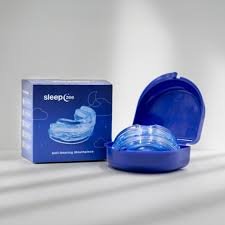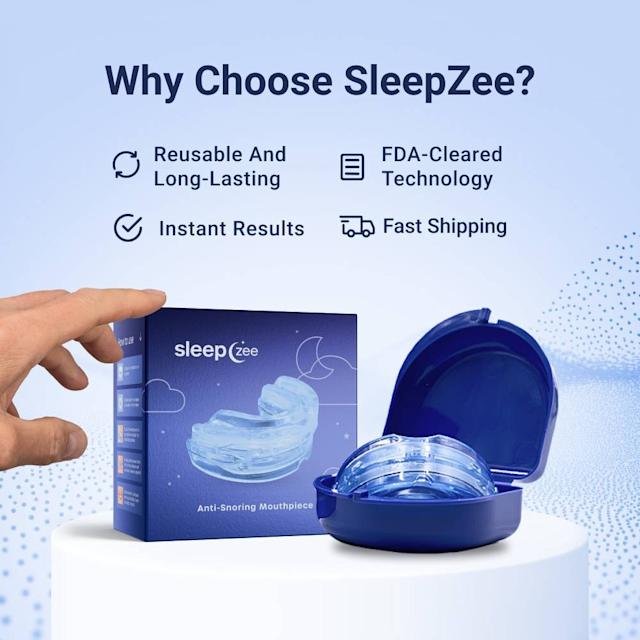SleepZee : Can This Smart Sleep Solution Help You Rest Better?
Introduction
Sleep is the foundation of our health, mood and productivity. Yet for many people, restful nights are elusive—snoring, restless sleep, waking up tired, even partner-disturbance all contribute. That’s where SleepZee enters the picture: a device designed not just to mask the symptom (snoring) but to target one of the causes (airflow obstruction during sleep). In this blog we’ll explore what SleepZee is, how it claims to work, what the evidence says, who should (and shouldn’t) use it, and how to get the best out of it.

What is SleepZee?
SleepZee is an anti-snoring mouthpiece (sometimes called a mandibular advancement device, or MAD) that is marketed for adults who snore, and who want a non-invasive solution. According to the brand:
-
It gently advances the lower jaw (mandible) forward during sleep, which helps open the airway, reduce tissue vibration and therefore reduce snoring.
-
It uses “boil-and-bite” technology: you heat the mouthpiece in hot water, then bite gently to mould it to your dental profile for a custom fit.
-
It is made from medical-grade, BPA-free, allergy-safe material (e.g., latex-free) and is adjustable to different jaw positions.
-
It’s marketed with a “30-night money-back guarantee” and claims to have many thousands of users.
-
It clearly states that it is not a treatment for severe sleep apnea, although it may help mild to moderate cases.
In short: SleepZee is positioned as a reasonably affordable, at-home, self-fittable mouthpiece to reduce snoring and improve sleep quality by improving airway patency.
How Does SleepZee Work?
Understanding the mechanism helps us evaluate how much it might help, and in what situations.
1. Snoring and airway dynamics
Snoring occurs when airflow during sleep causes vibrating of soft tissues in the upper airway (back of throat, soft palate, tongue base). Blockage or narrowing of the airway causes turbulent air and tissue vibration. If the lower jaw falls back or the tongue obstructs, the airway narrows. A mandibular advancement device (MAD) pushes the lower jaw (and tongue base) slightly forward, increasing the size of the airway, reducing vibration and thus reducing snoring. Reviews of similar MADs back this mechanism.
2. SleepZee’s specific mechanism
According to SleepZee’s documentation:
-
The mouthpiece positions (advances) the lower jaw forward a few millimetres, which also moves the tongue slightly forward. This opens up the airway passage.
-
It is custom-moulded to your teeth via boil-and-bite, which improves fit and comfort (and thus compliance).
-
There are adjustable jaw-positions (some devices allow 10 levels of forward adjustment) so you can find the balance of comfortable jaw position vs effective airway openness.
-
It is reusable (somewhat) and designed for nightly use.
3. Intended benefits
The intended benefits are:
-
Reduced snoring → quieter nights for user and partner.
-
Improved airflow → less airway obstruction → fewer arousals from partial blockage → deeper/more restful sleep.
-
Morning benefits: waking less tired, better mood, better daytime focus.
-
Indirect benefits: less partner disturbance, improved relationship dynamics, less embarrassment.
Who Is SleepZee For?
Knowing who is likely to benefit (and who may not) is key to making a good decision.
Good candidates
-
Adults who snore regularly, particularly due to jaw/tongue position rather than anatomical abnormalities.
-
Those whose snoring is disturbing their partner or affecting their sleep quality (waking up tired).
-
People who prefer a non-invasive, self-fittable option rather than CPAP machine or surgery.
-
People who do not have severe obstructive sleep apnea (OSA), or major dental/jaw issues.
-
People who are willing to spend time fitting and adjusting the device, cleaning it, getting used to jaw position.
Less ideal candidates / caution
-
Individuals with diagnosed moderate to severe obstructive sleep apnea (OSA). SleepZee Mouthpiece explicitly states it is not a medical treatment for severe OSA.
-
People with major dental issues: loose teeth, dentures, bridges, or TMJ (temporomandibular joint) disorders. These may make wearing a jaw-advance device uncomfortable or risky.
-
People who cannot tolerate any jaw forward movement (jaw pain, discomfort).
-
People who expect instant miracle effect; adjustment takes a few nights in many cases.
-
Those who may need professional custom-fitted devices (dentist/orthodontist fitted MAD) rather than generic device.
In reviews, experts caution:
“Will SleepZee stop my snoring completely? Some users see significant reduction; few see total elimination. Results vary with anatomy, fit quality, and lifestyle factors.”
Also:
“Those are garbage. Custom MAD only.
So realism is important: it’s a good option for many snorers, but not a guaranteed cure for all.
Pros & Cons
Let’s break down the advantages and limitations based on available info.
Pros
-
Non-invasive: No surgery, no CPAP hose.
-
Self-fittable at home: Boil-and-bite method means no dentist visit required (in most cases).
-
Customisable fit: With adjustable levels of jaw advancement, better comfort and effectiveness.
-
Medical-grade materials (BPA-free, allergy-safe) and often reusable.
-
Money-back guarantee (30 days) reduces risk for buyer.
-
Potential for significant improvement in sleep for user and partner. Reviews show many users report quieter nights.
Cons
-
Not suitable for everyone (see above: severe OSA, dental issues).
-
Results vary: some users may see little benefit if fit is poor or anatomical issue is more complex.
-
There may be discomfort initially: jaw soreness, dry mouth, adjusting to new fit.
-
Generic devices may not match the quality of custom-fitted ones; some critics say off-the-shelf MADs are less effective.
-
Requires consistent nightly use, cleaning and maintenance for best outcome.
-
The company information mostly from brand website; independent long-term studies may be limited.
-
Import/shipping to India may incur cost/tax; fit may depend on local dentistry norms.
How to Use SleepZee Properly
Using the device correctly maximises the chance of success. Here’s a recommended step-by-step (based on manufacturer instructions + good practice).

-
Initial fit & moulding
-
Boil water (according to instructions) and soften the mouthpiece.
-
Insert the softened piece, bite gently and hold for the required time so it molds to your teeth and jaw alignment.
-
Cool it in cold water.
-
Adjust the jaw-position setting (if device allows multiple levels) to a comfortable forward position that doesn’t feel forced or painful.
-
-
Nightly use
-
Wear the device every night. The more consistent you are, the quicker you’ll adapt and see benefit.
-
Make sure your mouthpiece is clean, dry and stored properly. Poor hygiene can reduce effectiveness or cause discomfort.
-
-
Adjustment period
-
For the first few nights, you might experience mild jaw soreness or strange sensation; this is common. Give your jaw a few nights to adapt.
-
If discomfort persists, go back to a less aggressive jaw advance setting, or remould the device (some devices allow remoulding).
-
Make sure you are sleeping in a reasonable position (avoid extreme supine mouth-open positions which may still collapse airway). Lifestyle factors also matter.
-
-
Cleaning & maintenance
-
Rinse device after each use. Some advise mild soap + toothbrush.
-
Inspect for wear and tear; manufacturer says lasting ~4-6 months with care.
-
Replace when it becomes loose, cracked, or uncomfortable.
-
-
Lifestyle factors
-
Combine with good sleep-hygiene: regular bedtime, avoid heavy meals/alcohol before bed, maintain healthy weight, elevate head of bed if needed.
-
Address other snoring contributors: nasal congestion, sleeping position, alcohol use, medications. The device may help, but underlying causes still matter.
-
-
Monitor results
-
Ask partner/family if they notice reduction in snoring.
-
Monitor how you feel: fewer awakenings, higher morning energy, less daytime fatigue.
-
If no improvement after several weeks, reconsider fit, or consult a healthcare professional (especially if signs of OSA exist).
-
What Do Reviews & Experts Say?
Evaluating independent reviews helps temper expectations and separate marketing claims from reality.
Independent Review Snapshot
-
One review (Consumer Health Digest) noted that SleepZee was “proven highly effective in reducing snoring and improving sleep quality. Many users report experiencing quieter nights from the very first use.”
-
The same review also warned: it’s generally safe but “not a replacement for CPAP therapy for severe sleep apnea.” Good caution.
-
Another review from “Eventual Healthcare” listed the pros and cons: adjustable design, comfort, easy cleaning; but noted cons like possible initial jaw soreness, mixed long-term effectiveness, and product origin/custom-fit concerns.
-
A blog on VitalSleep emphasised that while SleepZee can be worth trying for mild/moderate snoring, you should check return policy, and the fit matters.
Summary
In summary: the independent reviews suggest that devices like SleepZee can help significantly for many snorers (particularly those with jaw/tongue based obstruction), but results are variable, fit and anatomical factors matter, and it’s not a universal solution. Also, if someone has signs of obstructive sleep apnea (daytime sleepiness, witnessed apneas, high BMI, hypertension), they should consult a doctor rather than rely solely on the device.
Is SleepZee Worth It?
Let’s weigh up the value, especially for someone in India (or generally) considering purchase.
My verdict
For someone in India who snores and is looking for a relatively affordable, non-invasive option, SleepZee is worth trying, as long as they:
-
Do not assume miracle cure;
-
Commit to proper fitting and nightly use;
-
Maintain expectations realistic;
-
Are aware that severe sleep apnea might require more than this;
-
Buy from a verified source and check return policy.
As one reviewer put it:
“Will SleepZee stop my snoring completely? … Some users see significant reduction; few see total elimination. Results vary with anatomy, fit quality, and lifestyle factors.”
Thus, if you see a good discount, understand the terms, it can be a good “first step” in snoring reduction strategy.
Tips for Maximising Success with SleepZee
Here are some suggestions to get the most out of your SleepZee device:
-
Spend time on initial fitting: The better the fit, the more effective it will be. If you’re not comfortable after first night, remould or adjust.
-
Use nightly: consistency builds adaptation and benefit.
-
Combine with sleep hygiene: keep bedroom cool, dark, reduce alcohol/caffeine before bed, avoid heavy meals late, stop using screens at least an hour before bed.
-
Use positional strategies: For many snorers, sleeping on the back makes snoring worse. Try side-sleeping or elevated head position.
-
Manage nasal congestion: If you have a blocked nose (allergies, deviated septum) then even with jaw advance, nasal resistance may still trigger snoring. Use nasal sprays or see ENT to optimise.
-
Keep device clean: rinse nightly, inspect regularly, store in dry case. A worn or dirty device will be less comfortable and less effective.
-
Track your progress: Ask partner whether snoring reduced, how you feel in the morning, how many awakenings you had. If nothing improves in 2-3 weeks, reconsider fit or device type.
-
Consult a professional if: you experience daytime sleepiness, witnessed pauses in breathing at night, high blood pressure, or if your jaw/mouth pain persists. These may indicate sleep apnea needing more than just a mouthpiece.
-
Budget for replacement: The manufacturer suggests device lasts ~4-6 months; after that, fit or material may degrade.
Conclusion
In the quest for restful, snore-free nights, SleepZee offers a compelling option: non-invasive, self-fittable, adjustable and comparatively affordable. For many adults with snoring caused by jaw/tongue obstruction (rather than major anatomical abnormalities), it may provide meaningful improvement — quieter nights for both you and your partner, improved daytime energy, and better sleep quality.